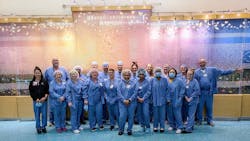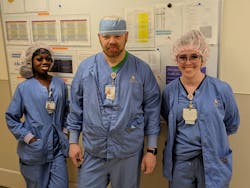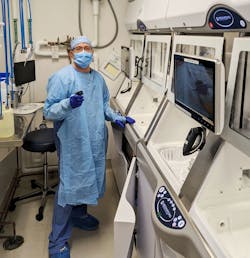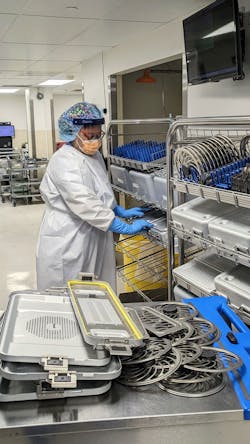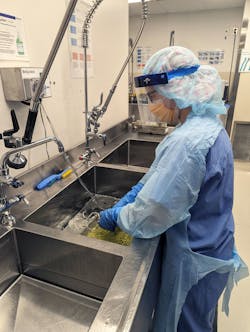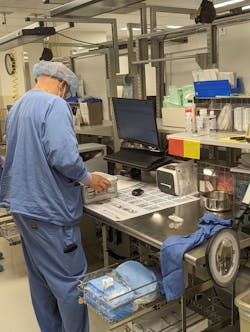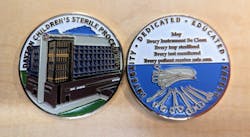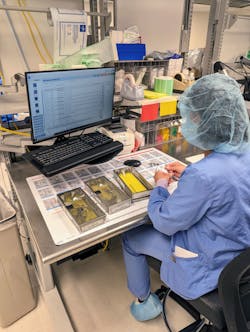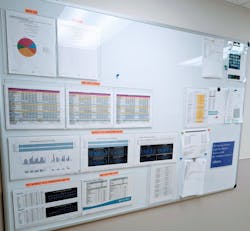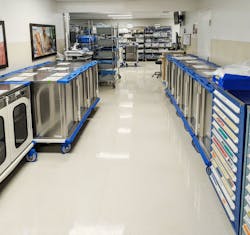Interdisciplinary collaboration drives process improvement, error reduction and SPD/OR satisfaction
Dayton Children's Hospital Fast Facts:
Total Surgery Suites: 15
Years of Experience: 389
Hospital Beds: 181
“It’s time to burn the village,” was the sentiment expressed by a surgeon with whom Tony Thurmond met upon taking the position of manager of Dayton Children’s Hospital’s sterile processing department (SPD) in October 2020. Issues with timely reprocessing, missing instruments and inoperable endoscopes resulted in “a loss of faith” in the sterile processing team among some physicians.
Thurmond was no stranger to perioperative services at Dayton Children’s Hospital; he began his civilian career there as an operating room (OR) scrub tech upon completing his service in the U.S. Air Force in 1996. Over 20 years later, he was back, but this time leading the SPD in a collaborative effort with the OR to improve instrument reprocessing quality and safety.
Like many SPDs, Dayton Children’s Hospital’s team was performing the best they could with what they were given as they struggled with staffing shortages, inconsistent scheduling, and insufficient inventory to support growing procedural volumes.
“The SPD team recognized the need to address concerns from surgical staff and physicians, but they also needed to know that their customers and executive leadership understood their challenges and limitations in meeting expectations and processing demands,” Thurmond told Healthcare Purchasing News. “Fortunately, we had immediate buy-in from the surgical staff.”
Over the past two and a half years, Dayton Children’s Hospital’s SPD and OR teams have worked “cohesively and deliberately to steer the safest practices and meet identified quality improvement goals” in the words of Thurmond. They have excelled in this work: achieving a 99.86% error-free tray rate, 99.78% non-immediate use steam sterilization (IUSS) rate, and a 95% POU treatment rate, all while increasing the percentage of trays processed by 61% from 2019 to 2022.
In the spirit of continuous improvement, they have pursued other initiatives that push the traditional bounds of the SPD role - taking control over instrument reprocessing for the hospital’s clinics, supporting the OR’s emergency code planning, and even collaborating with the OR team to support the 96-hour long surgical separation of conjoined twins.
And the work doesn’t stop there - the Dayton Children’s Hospital SPD team follows a strategic plan that changes each year and must be monitored by leadership (and adjusted as needed). Each staff member must know the “WHY” behind each step of the plan.
“They must know that the search for success lies in each step, and that the actions are for the good of the department and the customers and patients we serve,” said Thurmond.
Through these efforts, the Dayton Children’s Hospital SPD team has brought its department from the brink of destruction by burning to the pinnacle of success in customer service, productivity, teamwork, education and training, and strategic outlook.
Today, they are living their organization’s mission in “the relentless pursuit of optimal health for every child within our reach.” For these reasons, Dayton Children’s Hospital has earned the 2023 SPD of the Year Award from HPN.
Scoping out instrument errors
Working in collaboration with OR staff, the Dayton Children’s Hospital’s SPD team has made tremendous strides in reducing tray errors and damaged instrumentation. The SPD processed 71,921 trays in 2022 for 11,522 surgical procedures with minimal errors (see table of results).
“The OR staff and surgeons have always expected precision from SPD, but the difference is now that the SPD staff expect it from themselves and the departments they serve,” said Ben Goodstein, vice president and chief ambulatory officer, Dayton Children’s Hospital. “That is the difference in our SPD team is that they know the ‘why’ behind the processes and techniques used in their department and they want to share that with others and be recognized as the true experts in their field.”
“When tray errors happen, we aim to provide awareness and education, not punitive charges,” Thurmond explained. “Errors are not approached with judgment or harshness, but with the purpose of understanding the event and how it can impact our patients. If the error continues to recur, however, a peer reviews the technician’s trays to ensure no mistakes are missed and to offer further guidance on proper procedure.”
“Having that confidence in their abilities, as individuals and teammates, prepares them for unforeseen challenges and poises them for remarkable results,” Goodstein added. “Just as they hold themselves accountable, they also hold others accountable to do the right thing each time for our patients.”
Aligning with industry standards
To improve the effectiveness, safety and efficiency of endoscope reprocessing, the Dayton Children’s Hospital SPD team designed, built and equipped a dedicated endoscope reprocessing room adjacent to the OR.
It supports the ANSI/AAMI ST91:2021 standard, featuring automatic reprocessors with pass-through windows, a borescope for scope inspection after manual cleaning; protein testing for both channeled and non-channeled scopes; and a “state-of-the-art” scope dryer. Furthermore, the team has achieved industry leading rates in the avoidance of preventable repairs for both rigid and small flexible scopes.
Improving POU treatment compliance
Another area where the team is using standards to drive best practices is in POU treatment. The SPD team had experienced trays coming into decontamination that clearly hadn’t been treated. The OR team believed they didn’t have enough time to perform POU treatment because of high-case turnover.
To back their points with data, the SPD team added a scan in their decontamination area, as part of their instrument tracking system, to identify whether the trays were effectively treated at the POU before being transported. They discovered only 31% of trays had been treated.
With this technology in place, they were able to identify the surgical staff who failed to pretreat trays. To drive the point home, they presented photos of improper instrument care and handling. Additionally, they installed Stryker foam sprayers in key locations of the surgical suites to help support compliance.
As a result of their efforts, the percentage of trays being sprayed with moistening agents before being transported to the SPD rose to 95%.
Centralizing reprocessing for the clinics
A central theme and guiding principle among Dayton Children’s Hospital’s SPD staff members is “doing the right thing” even if that creates added work for the team.
The hospital’s clinics were responsible for transporting soiled instruments and retrieving their processed instruments from the SPD. But they struggled with staffing shortages, lack of transport container standardization, and inconsistencies in transport routes and type of carts used (open versus closed).
Hospital leaders turned to the SPD team for help, and they stepped up to the challenge, assuming responsibility for retrieving soiled instruments and delivering back to the clinic after the devices are processed. They established a set schedule for each clinic and standardized on transport containers and the use of a closed cart system. As they do with trays from inside the hospital, they use their instrument tracking system to document whether POU treatment was performed and report compliance metrics to the clinical manager.
“There are times in our department when we feel busy and overwhelmed so why would we take on more? In this case, we did what was best for the organization. We went in with education on POU treatment and told clinic staff, ‘if you do this part, we will do the rest.’ Now they can stay onsite caring for their patients instead of leaving to pick up/drop off instruments.”
Collaborating on specialized carts
The Dayton Children’s Hospital OR team required an Emergency Obstructed Airway Cart containing instruments they could use when a child presented with an obstructed airway. They previously had a cart with instruments that had been high-level disinfected laid out in drawers. The downside of this approach was the instruments could be touched or removed, compromising their safety and availability. It was also unclear whether the instruments had been processed.
The OR team wanted visibility to the instruments in the cart to ensure nothing was missing. They also preferred that the instruments be stored unsterile. The SPD and OR teams collaborated on a solution: the SPD built trays with age-specific instrumentation, endoscopes and accessories needed for the procedure to remove an airway obstruction. They are presented in the cart in a gusseted peel-pouch system, where the surgeon can easily view every instrument and supply present.
This Emergency Obstructed Airway Cart has proven to save time and ensure product availability and has led to improved surgeon satisfaction with sterilized instruments. It has become a standard for these emergent procedures.
Preparing for emergencies
The Dayton Children’s Hospital OR educators perform bi-monthly emergency code drills for different specialties. Recognizing the importance of alignment with the SPD on prompt and effective response, the OR team includes the SPD in code planning. This includes measuring SPD team response time, accuracy of cart pulls, and knowledge of their role as it pertains to the code(s). During a recent emergency code from a reaction to a drug after induction, Dayton Children’s Hospital’s leadership recognized SPD staff for their helpfulness and coordinated response.
Keeping the patient as the focus
Thurmond has prioritized efforts to connect his team with their impact on patient care. One way that he has done this is through challenge coins, which is a long-standing tradition in the military to honor achievements. In this case, the challenge coin that he presented to each of his team members reminds them of their importance in care delivery. It reads:
“May every instrument be clean, every tray sterilized, every test monitored, and every patient receive safe care.”
“We also shared the challenge coins with the surgical specialty chiefs to let them know this is our challenge to ourselves and we are sincere about it,” Thurmond added.
With SPD working behind the scenes away from the frontlines of patient care, staff members voiced concern on an internal survey that they do not always see the outcome of the procedures they support. SPD supervisor Tony Turner suggested a way to bring patients’ faces to staff members.
Working with the hospital’s aesthetics committee, the SPD team selected nine different professional photographs of patients who underwent surgery at the facility. The chosen images were framed and displayed throughout the SPD department, and in the hallway entrance to the department.
“During our huddles, we can look at those images on our walls and be instantly reminded why we are here,” said Thurmond. “In doing so, we talk about the outcomes of our patients and why we put in the effort for those we may never know.”
During the 10 months leading up to the planned surgery, the SPD team participated in mock drills and discussions around what to expect and challenges they may face. On the day the surgery commenced in April 2022, the team had “expertly and diligently prepared” all instrumentation and supplies for the procedure; one set for each child. The procedure, which was expected to take 19-24 hours, ended up lasting 96 hours in duration. The SPD team reprocessed instruments during intervals so they would be ready for the surgical team as needed.
“Often sterile processing is an afterthought, but in this case, the OR knew our role was important enough to have us there at the table with them from the very beginning,” said Thurmond. “While the surgeons and other surgical professionals were the true heroes of this successful separation, our team felt immense pride in knowing how much they, too, contributed to the positive outcomes. It was a highlight of many of our careers.”
Prioritizing education and certification
The Dayton Children’s Hospital SPD team, comprised of 31 full-time employees and four PRN staff members, is committed to continuing education and knowledge advancement for the sake of patient safety and exemplary care delivery, as evidenced by its 78% certification rate.
The department provides resource manuals and study guides at no cost to help prepare staff members for all the certification exams, pays for certification tests and works to prepare each technician for success.
Collectively, the team has a total of 46 certifications from both the Healthcare Sterile Processing Association (HSPA) and the Certification Board for Sterile Processing and Distribution (CBSPD), with two employees holding Golden Crown status (those who hold all four certifications from HSPA).
Dayton Children’s Hospital’s SPD leaders work to ensure their staff are capable and knowledgeable in using manufacturers’ instructions for use (IFU) and know how to access, read and follow them correctly. To reinforce this knowledge, they send out a quiz every three months, tasking team members to find answers to reprocessing questions in the department’s IFU repository.
SPD leadership cross-trains staff members for all jobs within the department, which allows for interchanging of roles, and staff members feeling more comfortable in their various roles. This includes proactively reviewing processes to ensure they follow the latest industry standards. They provide education through in person, online or assigned homework, and continually review departmental competencies to determine whether the frequency needs updating.
Driving success from the top down, and advancing from within
Thurmond says he and his team are extremely thankful that senior leadership is very supportive of all departments throughout the hospital, including SPD. Dayton Children’s Hospital’s president and CEO, Deborah Feldman, and vice presidents frequently engage in “walk-throughs” of the SPD, talking to staff members and asking, “what are your challenges and needs?”
“Senior leadership are more than willing to be open ear for us, and not just a pass by,” Thurmond explained. “Anything we have suggested they have been more than willing to listen to us. They know this is a hard-working team and are supportive all around – we couldn’t ask for better. When the CEO walks through our department, our staff members are excited that she is coming to talk to them – they love her visits.”
At the same time, SPD leaders encourage staff to be part of the decision-making process in the department. Their commitment to career advancement can be seen in the team’s structure, with three supervisors, two lead technicians, and an educator who have been promoted from within the department.
“I’ve been doing this for 38 years and the Dayton Children’s Hospital’s SPD team is the best team with which I’ve ever worked,” said Thurmond. “They understand the importance and urgency of our role and dig deeper to find better ways of doing things. Thank you for allowing us to share our SPD’s successes and recognizing our work with the HPN 2023 SPD Department of the Year Award.”
Successful vendor associations
All successful outcomes often come with successful partnerships. Dayton Children’s Hospital Sterile Processing Department would be amiss if we did not recognize the following vendors. Their contributions and willingness to help have been vital to develop opportunities we could not have accomplished alone.
Belimed helped us streamline a preventative maintenance schedule more sufficient to not interrupt department flow. Scheduling to meet our schedule helped keep equipment in compliance and problem-free. They also worked with our staff on the education of cleaning chemistries. This allowed our staff to understand the importance of maintaining cleaning chemistry for the effectiveness of its cleaning purposes.
Steris SPM came in with the equivalent of two upgrades due to the inability to visit during COVID. A four-day training session for all staff allowed the staff to become more familiar with the changes, and the opportunities to capture more information and utilize reports necessary to gain traction when interacting with customers. We now produce reports to show the point of use cleaning statistics, and exact pick-up and delivery of processed products.
Stryker Power was very instrumental in working with staff to understand the proper care and handling of power equipment to allow for the best result in longevity. Demonstrating how our Pro-Care contract would benefit us in better management of our equipment for longevity and performance has proven to save us on repairs and replacement. They also provided a point of use foaming system to be used in the operating room to allow the surgical team to become more involved in the cleaning process.
Steris supports our team with the most modern endoscopy cleaning and storage equipment for our remarkably busy endoscopy suite. Their input of education to our team and the continuous support to assure our machines are working thoroughly and efficiently. With their help and guidance, we have made our endoscope cleaning team one of the strongest in the nation.
Steris IMS has provided our team with top quality education and service that has made our team very proficient in identifying instruments in need of attention. Our team understands if there is a doubt, we will pull it aside for an inspection. Education has prepared them to identify issues and what to do when they are identified. We have the proper inspection equipment such as a borescope, scope inspection kits, instrument testing kits, etc., for staff to make their inspection process complete.
Karl Storz Endoscopy has been instrumental in providing education and guidance for ENT endoscopic procedures and instrumentation, as well as laparoscopic scopes and instrumentation. They were great resources when Sterile Processing developed an Emergency Airway Obstruction Cart developed to save time and assure accuracy during emergent procedures.
Integra Instrumentation has provided excellent help with instrumentation and was key to helping guide staff to the proper disassembly, cleaning, and reassembly of dermatomes. They have also provided a cross reference for ordering using another vendor catalog number.
About the Author
Kara Nadeau
Senior Contributing Editor
Kara Nadeau is Sterile Processing Editor for Healthcare Purchasing News.
